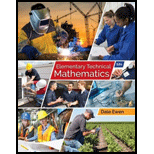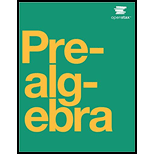
Elementary Technical Mathematics
12th Edition
ISBN: 9781337630580
Author: Dale Ewen
Publisher: Cengage Learning
expand_more
expand_more
format_list_bulleted
Concept explainers
Question
Chapter 16.8, Problem 23E
To determine
To calculate: The result of hexadecimal addition
Expert Solution & Answer
Want to see the full answer?
Check out a sample textbook solution
Students have asked these similar questions
question 10 please
00
(a) Starting with the geometric series Σ X^, find the sum of the series
n = 0
00
Σηχη - 1,
|x| < 1.
n = 1
(b) Find the sum of each of the following series.
00
Σnx",
n = 1
|x| < 1
(ii)
n = 1
sin
(c) Find the sum of each of the following series.
(i)
00
Σn(n-1)x^, |x| <1
n = 2
(ii)
00
n = 2
n²
- n
4n
(iii)
M8
n = 1
շո
(a) Use differentiation to find a power series representation for
1
f(x)
=
(4 + x)²*
f(x)
=
00
Σ
n = 0
What is the radius of convergence, R?
R =
(b) Use part (a) to find a power series for
f(x)
=
1
(4 + x)³°
f(x) =
00
Σ
n = 0
What is the radius of convergence, R?
R =
(c) Use part (b) to find a power series for
f(x)
=
x²
(4 + x)³*
00
f(x) = Σ
n = 2
What is the radius of convergence, R?
R =
Need Help? Read It
Watch It
SUBMIT ANSWER
Chapter 16 Solutions
Elementary Technical Mathematics
Ch. 16.1 - Change each binary number to decimal form: 11Ch. 16.1 - Prob. 2ECh. 16.1 - Prob. 3ECh. 16.1 - Prob. 4ECh. 16.1 - Prob. 5ECh. 16.1 - Prob. 6ECh. 16.1 - Prob. 7ECh. 16.1 - Prob. 8ECh. 16.1 - Prob. 9ECh. 16.1 - Prob. 10E
Ch. 16.1 - Prob. 11ECh. 16.1 - Prob. 12ECh. 16.1 - Prob. 13ECh. 16.1 - Prob. 14ECh. 16.1 - Prob. 15ECh. 16.1 - Prob. 16ECh. 16.1 - Change each binary number to decimal form:...Ch. 16.1 - Prob. 18ECh. 16.1 - Change each binary number to decimal form: 111111Ch. 16.1 - Prob. 20ECh. 16.2 - Prob. 1ECh. 16.2 - Prob. 2ECh. 16.2 - Prob. 3ECh. 16.2 - Prob. 4ECh. 16.2 - Prob. 5ECh. 16.2 - Prob. 6ECh. 16.2 - Prob. 7ECh. 16.2 - Prob. 8ECh. 16.2 - Prob. 9ECh. 16.2 - Prob. 10ECh. 16.2 - Prob. 11ECh. 16.2 - Prob. 12ECh. 16.2 - Prob. 13ECh. 16.2 - Prob. 14ECh. 16.2 - Prob. 15ECh. 16.2 - Add the following binary numbers and check your...Ch. 16.2 - Prob. 17ECh. 16.2 - Prob. 18ECh. 16.2 - Prob. 19ECh. 16.2 - Prob. 20ECh. 16.2 - Prob. 21ECh. 16.2 - Prob. 22ECh. 16.2 - Prob. 23ECh. 16.2 - Add the following binary numbers and check your...Ch. 16.2 - Prob. 25ECh. 16.2 - Prob. 26ECh. 16.2 - Add the following binary numbers and check your...Ch. 16.2 - Prob. 28ECh. 16.2 - Prob. 29ECh. 16.2 - Prob. 30ECh. 16.3 - Prob. 1ECh. 16.3 - Prob. 2ECh. 16.3 - Subtract the following binary numbers and check in...Ch. 16.3 - Prob. 4ECh. 16.3 - Subtract the following binary numbers and check in...Ch. 16.3 - Subtract the following binary numbers and check in...Ch. 16.3 - Prob. 7ECh. 16.3 - Prob. 8ECh. 16.3 - Prob. 9ECh. 16.3 - Subtract the following binary numbers and check in...Ch. 16.3 - Subtract the following binary numbers and check in...Ch. 16.3 - Prob. 12ECh. 16.3 - Prob. 13ECh. 16.3 - Prob. 14ECh. 16.3 - Subtract the following binary numbers and check in...Ch. 16.3 - Prob. 16ECh. 16.3 - Prob. 17ECh. 16.3 - Subtract the following binary numbers and check in...Ch. 16.3 - Prob. 19ECh. 16.3 - Prob. 20ECh. 16.3 - Prob. 21ECh. 16.3 - Prob. 22ECh. 16.3 - Prob. 23ECh. 16.3 - Prob. 24ECh. 16.3 - Prob. 25ECh. 16.3 - Prob. 26ECh. 16.3 - Prob. 27ECh. 16.3 - Prob. 28ECh. 16.3 - Prob. 29ECh. 16.3 - Use the 1s complement method to subtract the...Ch. 16.3 - Prob. 31ECh. 16.3 - Prob. 32ECh. 16.3 - Prob. 33ECh. 16.3 - Prob. 34ECh. 16.3 - Prob. 35ECh. 16.3 - Prob. 36ECh. 16.4 - Prob. 1ECh. 16.4 - Prob. 2ECh. 16.4 - Multiply the following binary numbers: 11010_Ch. 16.4 - Prob. 4ECh. 16.4 - Prob. 5ECh. 16.4 - Prob. 6ECh. 16.4 - Prob. 7ECh. 16.4 - Prob. 8ECh. 16.4 - Prob. 9ECh. 16.4 - Prob. 10ECh. 16.4 - Prob. 11ECh. 16.4 - Prob. 12ECh. 16.4 - Prob. 13ECh. 16.4 - Multiply the following binary numbers: 101101101_Ch. 16.4 - Prob. 15ECh. 16.4 - Prob. 16ECh. 16.4 - Prob. 17ECh. 16.4 - Prob. 18ECh. 16.4 - Prob. 19ECh. 16.4 - Prob. 20ECh. 16.5 - Prob. 1ECh. 16.5 - Prob. 2ECh. 16.5 - Prob. 3ECh. 16.5 - Prob. 4ECh. 16.5 - Prob. 5ECh. 16.5 - Prob. 6ECh. 16.5 - Prob. 7ECh. 16.5 - Prob. 8ECh. 16.5 - Prob. 9ECh. 16.5 - Prob. 10ECh. 16.5 - Prob. 11ECh. 16.5 - Prob. 12ECh. 16.5 - Prob. 13ECh. 16.5 - Prob. 14ECh. 16.5 - Prob. 15ECh. 16.5 - Prob. 16ECh. 16.5 - Prob. 17ECh. 16.5 - Prob. 18ECh. 16.5 - Prob. 19ECh. 16.5 - Prob. 20ECh. 16.6 - Prob. 1ECh. 16.6 - Prob. 2ECh. 16.6 - Prob. 3ECh. 16.6 - Prob. 4ECh. 16.6 - Prob. 5ECh. 16.6 - Prob. 6ECh. 16.6 - Prob. 7ECh. 16.6 - Prob. 8ECh. 16.6 - Prob. 9ECh. 16.6 - Prob. 10ECh. 16.6 - Prob. 11ECh. 16.6 - Prob. 12ECh. 16.6 - Prob. 13ECh. 16.6 - Prob. 14ECh. 16.6 - Prob. 15ECh. 16.6 - Prob. 16ECh. 16.6 - Prob. 17ECh. 16.6 - Prob. 18ECh. 16.6 - Prob. 19ECh. 16.6 - Change each binary number to decimal form:...Ch. 16.7 - Prob. 1ECh. 16.7 - Prob. 2ECh. 16.7 - Prob. 3ECh. 16.7 - Prob. 4ECh. 16.7 - Prob. 5ECh. 16.7 - Prob. 6ECh. 16.7 - Prob. 7ECh. 16.7 - Prob. 8ECh. 16.7 - Prob. 9ECh. 16.7 - Prob. 10ECh. 16.7 - Prob. 11ECh. 16.7 - Prob. 12ECh. 16.7 - Prob. 13ECh. 16.7 - Change each hexadecimal number to decimal form:...Ch. 16.7 - Prob. 15ECh. 16.7 - Prob. 16ECh. 16.7 - Prob. 17ECh. 16.7 - Prob. 18ECh. 16.7 - Prob. 19ECh. 16.7 - Prob. 20ECh. 16.7 - Prob. 21ECh. 16.7 - Prob. 22ECh. 16.7 - Prob. 23ECh. 16.7 - Prob. 24ECh. 16.7 - Prob. 25ECh. 16.7 - Prob. 26ECh. 16.7 - Prob. 27ECh. 16.7 - Prob. 28ECh. 16.7 - Prob. 29ECh. 16.7 - Prob. 30ECh. 16.8 - Prob. 1ECh. 16.8 - Prob. 2ECh. 16.8 - Prob. 3ECh. 16.8 - Prob. 4ECh. 16.8 - Prob. 5ECh. 16.8 - Prob. 6ECh. 16.8 - Prob. 7ECh. 16.8 - Prob. 8ECh. 16.8 - Prob. 9ECh. 16.8 - Prob. 10ECh. 16.8 - Prob. 11ECh. 16.8 - Prob. 12ECh. 16.8 - Prob. 13ECh. 16.8 - Prob. 14ECh. 16.8 - Prob. 15ECh. 16.8 - Prob. 16ECh. 16.8 - Prob. 17ECh. 16.8 - Prob. 18ECh. 16.8 - Prob. 19ECh. 16.8 - Prob. 20ECh. 16.8 - Prob. 21ECh. 16.8 - Prob. 22ECh. 16.8 - Prob. 23ECh. 16.8 - Prob. 24ECh. 16.8 - Prob. 25ECh. 16.8 - Prob. 26ECh. 16.8 - Add the following hexadecimal numbers. Check using...Ch. 16.8 - Prob. 28ECh. 16.8 - Prob. 29ECh. 16.8 - Prob. 30ECh. 16.8 - Prob. 31ECh. 16.8 - Prob. 32ECh. 16.8 - Prob. 33ECh. 16.8 - Prob. 34ECh. 16.8 - Prob. 35ECh. 16.8 - Prob. 36ECh. 16.8 - Prob. 37ECh. 16.8 - Prob. 38ECh. 16.8 - Prob. 39ECh. 16.8 - Prob. 40ECh. 16.8 - Prob. 41ECh. 16.8 - Prob. 42ECh. 16.8 - Prob. 43ECh. 16.8 - Prob. 44ECh. 16.8 - Prob. 45ECh. 16.8 - Prob. 46ECh. 16.8 - Prob. 47ECh. 16.8 - Prob. 48ECh. 16.8 - Prob. 49ECh. 16.8 - Prob. 50ECh. 16.8 - Prob. 51ECh. 16.8 - Prob. 52ECh. 16.8 - Prob. 53ECh. 16.8 - Prob. 54ECh. 16.8 - Prob. 55ECh. 16.8 - Prob. 56ECh. 16.8 - Prob. 57ECh. 16.8 - Prob. 58ECh. 16.8 - Prob. 59ECh. 16.8 - Prob. 60ECh. 16.9 - Prob. 1ECh. 16.9 - Prob. 2ECh. 16.9 - Prob. 3ECh. 16.9 - Prob. 4ECh. 16.9 - Prob. 5ECh. 16.9 - Prob. 6ECh. 16.9 - Prob. 7ECh. 16.9 - Prob. 8ECh. 16.9 - Prob. 9ECh. 16.9 - Prob. 10ECh. 16.9 - Prob. 11ECh. 16.9 - Prob. 12ECh. 16.9 - Prob. 13ECh. 16.9 - Prob. 14ECh. 16.9 - Prob. 15ECh. 16.9 - Prob. 16ECh. 16.9 - Prob. 17ECh. 16.9 - Prob. 18ECh. 16.9 - Prob. 19ECh. 16.9 - Prob. 20ECh. 16.9 - Prob. 21ECh. 16.9 - Prob. 22ECh. 16.9 - Prob. 23ECh. 16.9 - Change each binary number to hexadecimal form:...Ch. 16.9 - Prob. 25ECh. 16.9 - Prob. 26ECh. 16.9 - Prob. 27ECh. 16.9 - Prob. 28ECh. 16.9 - Prob. 29ECh. 16.9 - Prob. 30ECh. 16.9 - Prob. 31ECh. 16.9 - Prob. 32ECh. 16.9 - Prob. 33ECh. 16.9 - Prob. 34ECh. 16.9 - Prob. 35ECh. 16.9 - Prob. 36ECh. 16.9 - Prob. 37ECh. 16.9 - Prob. 38ECh. 16.9 - Prob. 39ECh. 16.9 - Prob. 40ECh. 16.9 - Prob. 41ECh. 16.9 - Prob. 42ECh. 16.9 - Prob. 43ECh. 16.9 - Prob. 44ECh. 16 - Prob. 1RCh. 16 - Prob. 2RCh. 16 - Prob. 3RCh. 16 - Prob. 4RCh. 16 - Prob. 5RCh. 16 - Prob. 6RCh. 16 - Add the following binary numbers: 1001110101_Ch. 16 - Prob. 8RCh. 16 - Prob. 9RCh. 16 - Prob. 10RCh. 16 - Prob. 11RCh. 16 - Prob. 12RCh. 16 - Prob. 13RCh. 16 - Prob. 14RCh. 16 - Prob. 15RCh. 16 - Prob. 16RCh. 16 - Prob. 17RCh. 16 - Prob. 18RCh. 16 - Prob. 19RCh. 16 - Prob. 20RCh. 16 - Prob. 21RCh. 16 - Prob. 22RCh. 16 - Prob. 23RCh. 16 - Prob. 24RCh. 16 - Prob. 25RCh. 16 - Prob. 26RCh. 16 - Prob. 27RCh. 16 - Prob. 28RCh. 16 - Prob. 29RCh. 16 - Prob. 30RCh. 16 - Prob. 1TCh. 16 - Prob. 2TCh. 16 - Prob. 3TCh. 16 - Prob. 4TCh. 16 - Prob. 5TCh. 16 - Prob. 6TCh. 16 - Prob. 7TCh. 16 - Prob. 8TCh. 16 - Prob. 9TCh. 16 - Prob. 10TCh. 16 - Prob. 11TCh. 16 - Prob. 12TCh. 16 - Prob. 13TCh. 16 - Prob. 14TCh. 16 - Prob. 15TCh. 16 - Prob. 16TCh. 16 - Prob. 17TCh. 16 - Prob. 18TCh. 16 - Prob. 19TCh. 16 - Prob. 20TCh. 16 - Prob. 1CRCh. 16 - Prob. 2CRCh. 16 - Prob. 3CRCh. 16 - Prob. 4CRCh. 16 - Prob. 5CRCh. 16 - Prob. 6CRCh. 16 - Prob. 7CRCh. 16 - Prob. 8CRCh. 16 - Prob. 9CRCh. 16 - Prob. 10CRCh. 16 - Prob. 11CRCh. 16 - Prob. 12CRCh. 16 - Prob. 13CRCh. 16 - Prob. 14CRCh. 16 - Prob. 15CRCh. 16 - Prob. 16CRCh. 16 - Prob. 17CRCh. 16 - Prob. 18CRCh. 16 - Prob. 19CRCh. 16 - Prob. 20CRCh. 16 - Prob. 21CRCh. 16 - Prob. 22CRCh. 16 - Prob. 23CRCh. 16 - Prob. 24CRCh. 16 - Do as indicated for the following binary numbers:...Ch. 16 - Prob. 26CRCh. 16 - Prob. 27CRCh. 16 - Prob. 28CRCh. 16 - Prob. 29CRCh. 16 - Prob. 30CR
Knowledge Booster
Learn more about
Need a deep-dive on the concept behind this application? Look no further. Learn more about this topic, subject and related others by exploring similar questions and additional content below.Similar questions
- W AutoSave Off Soal Latihan Matdis (1) ▼ Search File Home Insert Draw Design Layout References Mailings Review View Help Aptos (Body) ✓ 12 A A Aa Ро Paste BI U ab x, x² A ✓ A ད Clipboard ₪ 24 23 22 21 20 19 18 17 16 15 1″ ידידיו Page 1 of 1 25°C 215 words Berawan E> M Font 四 Paragraph 3 4 1 56 ☑ 781 LI Comments Editing Find ✓ Normal No Spacing Heading Replace Add-ins Select Styles ☑ Editing Add-ins 91 10 111 12 | 13| 14 15 5. Suppose you wanted to draw a quadrilateral using the dots below as vertices (corners). The dots are spaced one unit apart horizontally and two units apart vertically. a) How many quadrilaterals are possible? b) How many are squares? How many are rectangles? c) How many are parallelograms? English (Indonesia) Accessibility: Investigate R - W ☑ Share ▾ Focus + 100% 00:17 13/04/2025arrow_forwardanswer for question 4 pleasearrow_forwardThe joint density function of two continuous random variables X and Y is: p(x, y) = {Kcos(x + y) Find (i) the constant K 0 0arrow_forwardp(x,y) = {e-x -(x+y) 0 x ≥ 0, y ≥ 0 otherwise find x,y,Exy, by Охarrow_forward2. Show that 8 xa S -dx (b² + 12) dr = 2 cos(π2) пра-1 a, b real and -1 0 Your solution should clearly explain the closed contour you are using, and state clearly any vanishing properties of integrals over contours that are being used. You are free to quote from the lectures, the appropriate results on such vanishing properties, without deriving these properties. Any residue calculations involved should be explained clearly.arrow_forwardCould you please answer this question using excel.Thanksarrow_forward1. Calculate the integral 500 x sin x (a² +x2)20 dx by using the residue theorem. You may assume that a is real and a > 0. Your solution should clearly explain the closed contour you are using, and state clearly any vanishing properties of integrals over contours that are being used.arrow_forwardQuestions An insurance company's cumulative incurred claims for the last 5 accident years are given in the following table: Development Year Accident Year 0 2018 1 2 3 4 245 267 274 289 292 2019 255 276 288 294 2020 265 283 292 2021 263 278 2022 271 It can be assumed that claims are fully run off after 4 years. The premiums received for each year are: Accident Year Premium 2018 306 2019 312 2020 318 2021 326 2022 330 You do not need to make any allowance for inflation. 1. (a) Calculate the reserve at the end of 2022 using the basic chain ladder method. (b) Calculate the reserve at the end of 2022 using the Bornhuetter-Ferguson method. 2. Comment on the differences in the reserves produced by the methods in Part 1.arrow_forwardCalculate the correlation coefficient r, letting Row 1 represent the x-values and Row 2 the y-values. Then calculate it again, letting Row 2 represent the x-values and Row 1 the y-values. What effect does switching the variables have on r? Row 1 Row 2 13 149 25 36 41 60 62 78 S 205 122 195 173 133 197 24 Calculate the correlation coefficient r, letting Row 1 represent the x-values and Row 2 the y-values. r=0.164 (Round to three decimal places as needed.) S 24arrow_forwardThe number of initial public offerings of stock issued in a 10-year period and the total proceeds of these offerings (in millions) are shown in the table. The equation of the regression line is y = 47.109x+18,628.54. Complete parts a and b. 455 679 499 496 378 68 157 58 200 17,942|29,215 43,338 30,221 67,266 67,461 22,066 11,190 30,707| 27,569 Issues, x Proceeds, 421 y (a) Find the coefficient of determination and interpret the result. (Round to three decimal places as needed.)arrow_forwardQuestions An insurance company's cumulative incurred claims for the last 5 accident years are given in the following table: Development Year Accident Year 0 2018 1 2 3 4 245 267 274 289 292 2019 255 276 288 294 2020 265 283 292 2021 263 278 2022 271 It can be assumed that claims are fully run off after 4 years. The premiums received for each year are: Accident Year Premium 2018 306 2019 312 2020 318 2021 326 2022 330 You do not need to make any allowance for inflation. 1. (a) Calculate the reserve at the end of 2022 using the basic chain ladder method. (b) Calculate the reserve at the end of 2022 using the Bornhuetter-Ferguson method. 2. Comment on the differences in the reserves produced by the methods in Part 1.arrow_forwardSteel Production Planning: Let S represent the amount of steel produced (in tons). Steel Production is related to the amount of labor used(L) and the amount of capital used ( C ) by the following function:S = 20L⁰˙³⁰C⁰˙⁷⁰In this formula L represents the units of Labor input and C the units of Capital input. Each unit of Labor costs $50, and each unit of Capital costs $100. a:Formulate an optimization problem that will determine how much labor and capital are needed to produce 50,000 tons of steel at minimum cost. Q#3B: Solve the optimization problem you formulated in part (a). (Hint: When using Excel Solver, start with an initial L>0 and C>0.)…arrow_forwardarrow_back_iosSEE MORE QUESTIONSarrow_forward_ios
Recommended textbooks for you
 Mathematics For Machine TechnologyAdvanced MathISBN:9781337798310Author:Peterson, John.Publisher:Cengage Learning,
Mathematics For Machine TechnologyAdvanced MathISBN:9781337798310Author:Peterson, John.Publisher:Cengage Learning, Elementary AlgebraAlgebraISBN:9780998625713Author:Lynn Marecek, MaryAnne Anthony-SmithPublisher:OpenStax - Rice University
Elementary AlgebraAlgebraISBN:9780998625713Author:Lynn Marecek, MaryAnne Anthony-SmithPublisher:OpenStax - Rice University Algebra: Structure And Method, Book 1AlgebraISBN:9780395977224Author:Richard G. Brown, Mary P. Dolciani, Robert H. Sorgenfrey, William L. ColePublisher:McDougal Littell
Algebra: Structure And Method, Book 1AlgebraISBN:9780395977224Author:Richard G. Brown, Mary P. Dolciani, Robert H. Sorgenfrey, William L. ColePublisher:McDougal Littell Holt Mcdougal Larson Pre-algebra: Student Edition...AlgebraISBN:9780547587776Author:HOLT MCDOUGALPublisher:HOLT MCDOUGAL
Holt Mcdougal Larson Pre-algebra: Student Edition...AlgebraISBN:9780547587776Author:HOLT MCDOUGALPublisher:HOLT MCDOUGAL


Mathematics For Machine Technology
Advanced Math
ISBN:9781337798310
Author:Peterson, John.
Publisher:Cengage Learning,

Elementary Algebra
Algebra
ISBN:9780998625713
Author:Lynn Marecek, MaryAnne Anthony-Smith
Publisher:OpenStax - Rice University

Algebra: Structure And Method, Book 1
Algebra
ISBN:9780395977224
Author:Richard G. Brown, Mary P. Dolciani, Robert H. Sorgenfrey, William L. Cole
Publisher:McDougal Littell

Holt Mcdougal Larson Pre-algebra: Student Edition...
Algebra
ISBN:9780547587776
Author:HOLT MCDOUGAL
Publisher:HOLT MCDOUGAL


Sequences and Series Introduction; Author: Mario's Math Tutoring;https://www.youtube.com/watch?v=m5Yn4BdpOV0;License: Standard YouTube License, CC-BY
Introduction to sequences; Author: Dr. Trefor Bazett;https://www.youtube.com/watch?v=VG9ft4_dK24;License: Standard YouTube License, CC-BY